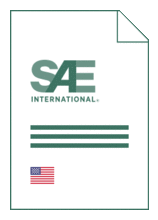Standards Worldwide
Standards Worldwide
Phone +49 30 58885700-07

Standard [CURRENT]
SAE J 2215:2021-01-07
Surface Match Verification Method for Pressure Sensitive Adhesively Attached Components
- Publication date
- 2021-01-07
- Original language
- English
- Pages
- 5
- Publication date
- 2021-01-07
- Original language
- English
- Pages
- 5
Product information on this site:
Quick delivery via download or delivery service
Buy securely with a credit card or pay upon receipt of invoice
All transactions are encrypted
Short description
This SAE Recommended Practice applies to evaluation of the conformance match condition existing between two surfaces. Evaluation of this conformance may be especially useful in bonded applications although it may also have relevance to bolted adjacent surface joint conditions. Since good bonding surface conformity is necessary for providing optimal bond performance with pressure sensitive adhesives, the purpose of this document is to provide a method of evaluating the conformance match of the mating surfaces. This document is intended as a guide toward standard practice but may be subject to frequent change to keep pace with experience and technical advances. This should be kept in mind when considering the use of this document. Tool types, materials, application tools, and component contact area evaluation methods are included as part of this document. In most cases a visual evaluation of contact performance may be satisfactory; however, for greater accuracy a measurement tool may be used. When reporting a contact value the mode of evaluation (e. g., visual, measurement tool) should be indicated.
Loading recommended items...
Loading recommended items...
Loading recommended items...
